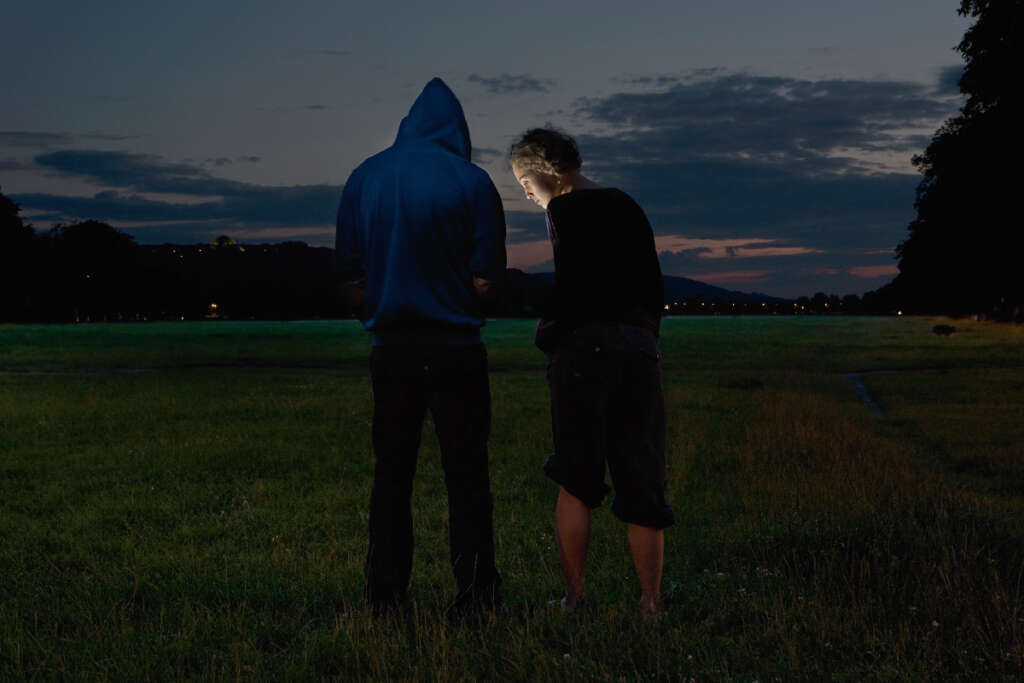Melancholy of light in the photographs of Jakub Pierzchała

Philip-Lorca diCorcia took a photograph in 1978 showing his brother Mario. The figure depicted in the photograph looks into an open refrigerator, illuminating the interior of the kitchen and the face of the portrayed with unnatural light. Undertaking an analysis of this work, Peter Galassi drew attention to the apparent ordinariness of the situation, occurring as a result of photographic direction. According to Galassi, diCorcia's experiment turned "a mundane event into an enigma." According to his interpretation, "looking at a man looking for a snack, we actually see a man facing his own failures and longings."
Typical features of this work, such as photographic direction, mysterious light, and the apparent banality of a situation filled with psychology, can be found in Jakub Pierzchała's series "Afterworlds". His photographs take up problems popular in contemporary photography, while at the same time being a continuation of the tradition of old painting.

One of Pierzchała's works gives the impression of a quotation that intentionally or unintentionally refers to the aforementioned diCorcia photograph. Similar to her, in the photograph by the Krakow photographer the central place of the composition is occupied by a figure standing in the kitchen, gazing into the open space of the kitchen cupboard. The figure in question here is a young woman, with her face illuminated by an indeterminate light source falling on her from inside the cabinet. Unlike diCorcia's photograph, the contents of the space she observes remain completely hidden. What is also striking is the emptiness that fills the ascetic, sterile and dim interior of the kitchen, in which the kettle, situated on the side, seems to be the only attribute of the place; the only everyday object. The strange and unnatural light becomes the sole focus of contemplation for the woman frozen in stillness. It absorbs the attention of the figure, taking her away from the mundane "kitchen reality. It penetrates the woman, passing into her mind.
Mysterious light absorbing the attention of people detached from everyday reality is undoubtedly the common denominator of the entire series of Pierzchała's works. In another photo, the photographer captured a pair of young people standing with their backs to the spectator - a hooded man and a young woman - shown at dusk in a grassy meadow. The man is most likely holding an unspecified light source in his hands, which illuminates the face of the woman looking in his direction. The turning of the figure is a significant gesture in this case. It confirms the mysteriousness of the situation, intended only for the eyes of the couple involved, clearly with their backs turned to us, as if distancing themselves from the curious gaze of bystanders. Moreover, in any case where the painting depicts people positioned with their backs, one of the readings may concern the psychological values of the representation, dominating the hidden, physical features of the figures in such a depiction.
One of the works shows two young men sitting on a couch, their gaze directed toward the uniformly white surface of a television screen illuminating the darkened interior of the room. This white emptiness of the screen symbolizes the actual purpose of the gaze. The typical gaze that characterizes most of the characters in the "Afterworld" series is the unseeing gaze. This is because they only seemingly look toward any specific places, things or scenes. In fact, their vision resembles the frozen gaze of a daydreamer, focused on himself and blinded by an external light that detaches him from the world, everyday life and the mundanity of the surrounding space. The gaze referred to here also applies to the figures looking out of windows, appearing in Pierzchala's subsequent works. Romantic paintings have repeatedly depicted concentrated figures looking through windows at external reality. However, like the figures in Pierzchała's photographic works, it was not the external world that was the subject in them. Rather, it is the interior of the person, also symbolized by the closed room, that plays a key role here. After all, in the photographs of the Krakow artist, we do not see the space outside the window, remaining in an area that is inaccessible to us. This indefinite object of viewing allowed Pierzchala to depict contemporary melancholics. The seriousness of gestures and grimaces emphatically confirms the melancholic states of the figures.
Natural outdoor light appears in very few of the Krakow photographer's images. Typically, scenes from Pierzchała's successive works are illuminated by subtle, artificial light sources, penetrating the dark, nocturnal spaces of successive photographs. In addition to the already mentioned photographs, circumstances of this type concern, for example, the work depicting a young man shown in profile, bending his head over the open and luminous trunk of a car. Once again, his gesture alludes to Mario's positioning from diCorcia's photograph. Although we can't see the contents of the trunk, we are almost certain that it is empty; that other than the light, there is nothing concrete in it. Artificial light also appears in a photograph showing a young girl sitting on the edge of a pool illuminated from below, captured from a high perspective. The gloomy mood of the environment makes it easier for the characters in Pierzchała's photographs to concentrate on themselves, to languish over undefined concerns, and to reach a state of meditative concentration.




The article appeared in issue 32 of "Fotografia Quarterly" in 2010
